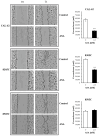The Potential Therapeutic Value of Aspirin in Anaplastic Thyroid Cancer
- PMID: 39766102
- PMCID: PMC11674608
- DOI: 10.3390/cancers16244203
The Potential Therapeutic Value of Aspirin in Anaplastic Thyroid Cancer
Abstract
Background: several experimental findings and epidemiological observations indicated that aspirin/acetylsalicylic acid (ASA) may be endowed with anticancer effects against a variety of human malignancies, including thyroid carcinomas. Among these, undifferentiated/anaplastic thyroid carcinoma (ATC) is one of the most aggressive and lethal human cancers, refractory to all currently available therapies. Methods: we here evaluated in a preclinical setting the effects of ASA on a panel of three ATC-derived cell lines: the CAL-62, the 8305C, and the 8505C. Results: the data obtained demonstrated the ability of ASA to inhibit, in a dose- and time-dependent manner, the proliferation of all ATC cell lines investigated, with IC50 values comprised between 2.0 and 4.3 mM. Cell growth was restrained with the same efficacy when the ASA treatment was applied to three-dimensional soft-agar cultures. In addition, ASA significantly reduced migration and invasion in two of the three ATC cell lines. We finally investigated the effects of ASA on the MAPK and PI3K/Akt signaling pathways, which are often altered in ATC. The results showed that the phosphorylation status of the Akt1/2/3 kinases was significantly reduced following ASA treatment, while ERK1/2 phosphorylation was either unaffected or slightly upregulated. Conclusions: our findings support epidemiological evidence on the anticancer potential of ASA. On this basis, further investigations should be carried out to assess the usefulness of ASA as adjuvant therapy in patients affected by ATC.
Keywords: anaplastic thyroid cancer; aspirin; therapy.
Conflict of interest statement
The authors declare no conflicts of interest.
Figures







Similar articles
-
S100A4 Knockout Sensitizes Anaplastic Thyroid Carcinoma Cells Harboring BRAFV600E/Mt to Vemurafenib.Cell Physiol Biochem. 2018;49(3):1143-1162. doi: 10.1159/000493296. Epub 2018 Sep 7. Cell Physiol Biochem. 2018. PMID: 30196299
-
Effects of the Aurora kinases pan-inhibitor SNS-314 mesylate on anaplastic thyroid cancer derived cell lines.Clin Ter. 2012;163(5):e307-13. Clin Ter. 2012. PMID: 23099978
-
Effects of the Aurora kinase inhibitor VX-680 on anaplastic thyroid cancer-derived cell lines.Endocr Relat Cancer. 2008 Jun;15(2):559-68. doi: 10.1677/ERC-08-0021. Epub 2008 Apr 22. Endocr Relat Cancer. 2008. PMID: 18430894
-
Personalized therapy in patients with anaplastic thyroid cancer: targeting genetic and epigenetic alterations.J Clin Endocrinol Metab. 2015 Jan;100(1):35-42. doi: 10.1210/jc.2014-2803. J Clin Endocrinol Metab. 2015. PMID: 25347569 Free PMC article. Review.
-
Immunotherapy or targeted therapy: What will be the future treatment for anaplastic thyroid carcinoma?Front Oncol. 2023 Mar 17;13:1103147. doi: 10.3389/fonc.2023.1103147. eCollection 2023. Front Oncol. 2023. PMID: 37007127 Free PMC article. Review.
Cited by
-
Acetylsalicylic acid and cancer: updates on the new potential of a nature-inspired drug.Naunyn Schmiedebergs Arch Pharmacol. 2025 Aug;398(8):9387-9403. doi: 10.1007/s00210-025-03959-6. Epub 2025 Mar 1. Naunyn Schmiedebergs Arch Pharmacol. 2025. PMID: 40021514 Review.
References
-
- Tomozawa S., Nagawa H., Tsuno N., Hatano K., Osada T., Kitayama J., Sunami E., Nita M.E., Ishihara S., Yano H., et al. Inhibition of haematogenous metastasis of colon cancer in mice by a selective COX-2 inhibitor, JTE-522. Br. J. Cancer. 1999;81:1274–1279. doi: 10.1038/sj.bjc.6694262. - DOI - PMC - PubMed
Grants and funding
LinkOut - more resources
Full Text Sources
Research Materials
Miscellaneous

